Risk Analysis and Management of Construction and Operations in Offshore Wind Power Project
Abstract
:1. Introduction
2. Literature Review
- Industrial safety accidents (56 cases): personnel injury and death caused by human error or unforeseeable circumstances.
- Equipment/facility accidents (55 cases): damage or failure of windfarm equipment or facilities.
- Lifting accidents (ten cases): accidents that occurred in lifting operations.
- Transportation accidents (12 cases): accidents involving working vessels.
- Environmental impact accidents (eight cases): pollution generated by the development of windfarms, or the biological, ecological, or environmental effects of their operation.
- Other accidents (20 cases): accidents with minor effects or public discontent.
3. Methods
3.1. Questionnaire Survey
3.2. Risk Impact-Frequency Analysis
3.3. Analytic Hierarchy Process
4. Risk Identification
4.1. Risk Categorization
4.2. Risk Breakdown Structure
5. Risk Analysis
5.1. Questionnaire Design Logic and Interviewee Backgrounds
5.2. RIFA Questionnaire Results and Analysis
5.3. AHP Questionnaire Results and Analysis
5.4. Comprehensive Ranking Based on Combined RIFA and AHP Results
6. Risk Response
6.1. Responses to Risks in Each Quadrant of the RIFA Diagram
6.2. Measures to Prevent Risk Factors
7. Conclusions and Recommendations
Author Contributions
Funding
Data Availability Statement
Acknowledgments
Conflicts of Interest
References
- 4C Offshore. Global Offshore Wind Speeds Rankings. Available online: https://www.4coffshore.com/windfarms/windspeeds.aspx (accessed on 31 August 2019).
- Chou, J.-S.; Chiu, C.-K.; Huang, I.K.; Chi, K.-N. Failure analysis of wind turbine blade under critical wind loads. Eng. Fail. Anal. 2013, 27, 99–118. [Google Scholar] [CrossRef]
- Chou, J.-S.; Ou, Y.-C.; Lin, K.-Y. Collapse mechanism and risk management of wind turbine tower in strong wind. J. Wind Eng. Ind. Aerodyn. 2019, 193, 103962. [Google Scholar] [CrossRef]
- Chou, J.-S.; Ou, Y.-C.; Lin, K.-Y.; Wang, Z.-J. Structural failure simulation of onshore wind turbines impacted by strong winds. Eng. Struct. 2018, 162, 257–269. [Google Scholar] [CrossRef]
- Chou, J.-S.; Tu, W.-T. Failure analysis and risk management of a collapsed large wind turbine tower. Eng. Fail. Anal. 2011, 18, 295–313. [Google Scholar] [CrossRef]
- Anaya-Lara, O.; Campos-Gaona, D.; Moreno-Goytia, E.; Adam, G. Offshore Wind Energy Generation: Control, Protection, and Integration to Electrical Systems; John Wiley & Sons, Ltd.: Hoboken, NJ, USA, 2014. [Google Scholar]
- CWIF. Wind Turbine Accident and Incident Compilation. Available online: http://www.caithnesswindfarms.co.uk/fullaccidents.pdf (accessed on 31 August 2019).
- Arakawa, C. Recent Development and Challenges of Wind Turbine Technology. Available online: https://www.jst.go.jp/sicp/ws2012_denmark/presentation/presentation_16.pdf (accessed on 17 September 2019).
- Kao, S.-M.; Pearre, N.S. Administrative arrangement for offshore wind power developments in Taiwan: Challenges and prospects. Energy Policy 2017, 109, 463–472. [Google Scholar] [CrossRef]
- Shih, C.-J. Evaluation of Liquefaction Potential in Western Taiwan Offshore Wind Farm; National Cheng Kung University: Tainan, Taiwan, 2013. [Google Scholar]
- Quarton, D. An International Design Standard for Offshore Wind Turbines: IEC 61400-3; Garrad Hassan and Partners, Ltd.: Bristol, UK, 2005. [Google Scholar]
- Negro, V.; López-Gutiérrez, J.-S.; Esteban, M.D.; Matutano, C. Uncertainties in the design of support structures and foundations for offshore wind turbines. Renew. Energy 2014, 63, 125–132. [Google Scholar] [CrossRef] [Green Version]
- DNV GL. Reducing Cyclone and Earthquake Challenges for Wind Turbines-New Wind Industry Project to Develop Joint Guideline. Available online: https://www.dnvgl.com/news/reducing-cyclone-and-earthquake-challenges-for-wind-turbines-144220 (accessed on 31 August 2019).
- IEC. Wind Energy Generation Systems-Part 3-1: Design Requirements for Fixed Offshore Wind Turbines. Available online: https://webstore.iec.ch/publication/29360 (accessed on 31 August 2019).
- PMI. Chapter 11 Project Risk Management. In PMBOK® Guide, 5th ed.; Project Management Institute: Philadelphia, PA, USA, 2013; pp. 309–354. [Google Scholar]
- Sinha, Y.; Steel, J.A. A progressive study into offshore wind farm maintenance optimisation using risk based failure analysis. Renew. Sustain. Energy Rev. 2015, 42, 735–742. [Google Scholar] [CrossRef]
- Leimeister, M.; Kolios, A. A review of reliability-based methods for risk analysis and their application in the offshore wind industry. Renew. Sustain. Energy Rev. 2018, 91, 1065–1076. [Google Scholar] [CrossRef]
- Park, J.; Kim, B. An analysis of South Korea’s energy transition policy with regards to offshore wind power development. Renew. Sustain. Energy Rev. 2019, 109, 71–84. [Google Scholar] [CrossRef]
- Mauleón, I. Assessing PV and wind roadmaps: Learning rates, risk, and social discounting. Renew. Sustain. Energy Rev. 2019, 100, 71–89. [Google Scholar] [CrossRef]
- Garbuzova-Schlifter, M.; Madlener, R. AHP-based risk analysis of energy performance contracting projects in Russia. Energy Policy 2016, 97, 559–581. [Google Scholar] [CrossRef]
- Wang, T.; Wang, S.; Zhang, L.; Huang, Z.; Li, Y. A major infrastructure risk-assessment framework: Application to a cross-sea route project in China. Int. J. Proj. Manag. 2016, 34, 1403–1415. [Google Scholar] [CrossRef]
- Yucesan, M.; Kahraman, G. Risk evaluation and prevention in hydropower plant operations: A model based on Pythagorean fuzzy AHP. Energy Policy 2019, 126, 343–351. [Google Scholar] [CrossRef]
- Eskander, R.F.A. Risk assessment influencing factors for Arabian construction projects using analytic hierarchy process. Alex. Eng. J. 2018, 57, 4207–4218. [Google Scholar] [CrossRef]
- Gatzert, N.; Kosub, T. Risks and risk management of renewable energy projects: The case of onshore and offshore wind parks. Renew. Sustain. Energy Rev. 2016, 60, 982–998. [Google Scholar] [CrossRef]
- Martilla, J.A.; James, J.C. Importance-performance analysis. J. Mark. 1977, 41, 77–79. [Google Scholar] [CrossRef]
- Saaty, T.L.; Kearns, K.P. Analytical Planning: The Organization of Systems; Pergamon: Oxford, UK, 1985. [Google Scholar]
- Saaty, T.L. Highlights and critical points in the theory and application of the Analytic Hierarchy Process. Eur. J. Oper. Res. 1994, 74, 426–447. [Google Scholar] [CrossRef]
- Saaty, T.L. Rank from comparisons and from ratings in the analytic hierarchy/network processes. Eur. J. Oper. Res. 2006, 168, 557–570. [Google Scholar] [CrossRef]
- Saaty, T.L.; Rokou, E. How to prioritize inventions. World Patent Inf. 2017, 48, 78–95. [Google Scholar] [CrossRef]
- Saaty, T.L. Analytic hierarchy process. In Encyclopedia of Biostatistics; John Wiley & Sons, Ltd.: Hoboken, NJ, USA, 2005. [Google Scholar] [CrossRef]
- Ahlgren, E.; Grudic, E. Risk Management in Offshore Wind Farm Development; Chalmers University of Technology: Gothenburg, Sweden, 2017. [Google Scholar]
- Aon UK Limited. Offshore Wind Risk Management and Insurance; Aon UK Limited: London, UK, 2018. [Google Scholar]
- Swiss Re. Offshore Wind Farm Discussion-Insurance Challenge and Case Review. Available online: https://www.ctci.org.tw/8831/ (accessed on 8 August 2019).
- EWEA. Where’s the Money Coming from? Financing Offshore Wind Farms. Available online: https://www.ewea.org/offshore2013/wp-content/uploads/Financing_Offshore_Executive_Summary.pdf (accessed on 15 July 2019).
- Risktec. De-Risking Offshore Wind Energy. Available online: https://risktec.tuv.com/risktec-knowledge-bank/enterprise-risk-management/de-risking-offshore-wind-energy/ (accessed on 4 June 2019).
- Aon UK Limited. Insurance and Risk Overview for Offshore Wind Farms; Aon UK Limited: London, UK, 2019. [Google Scholar]
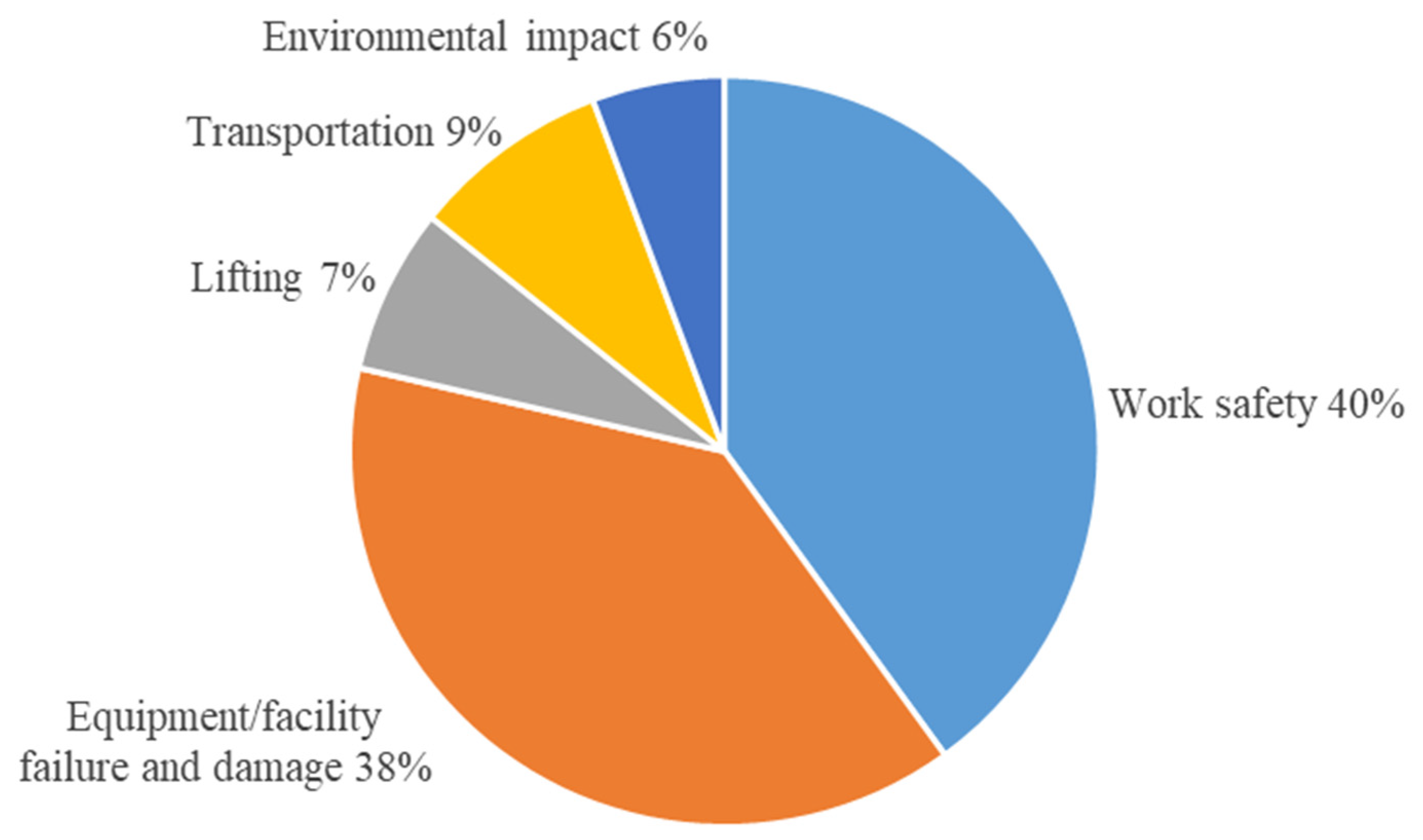
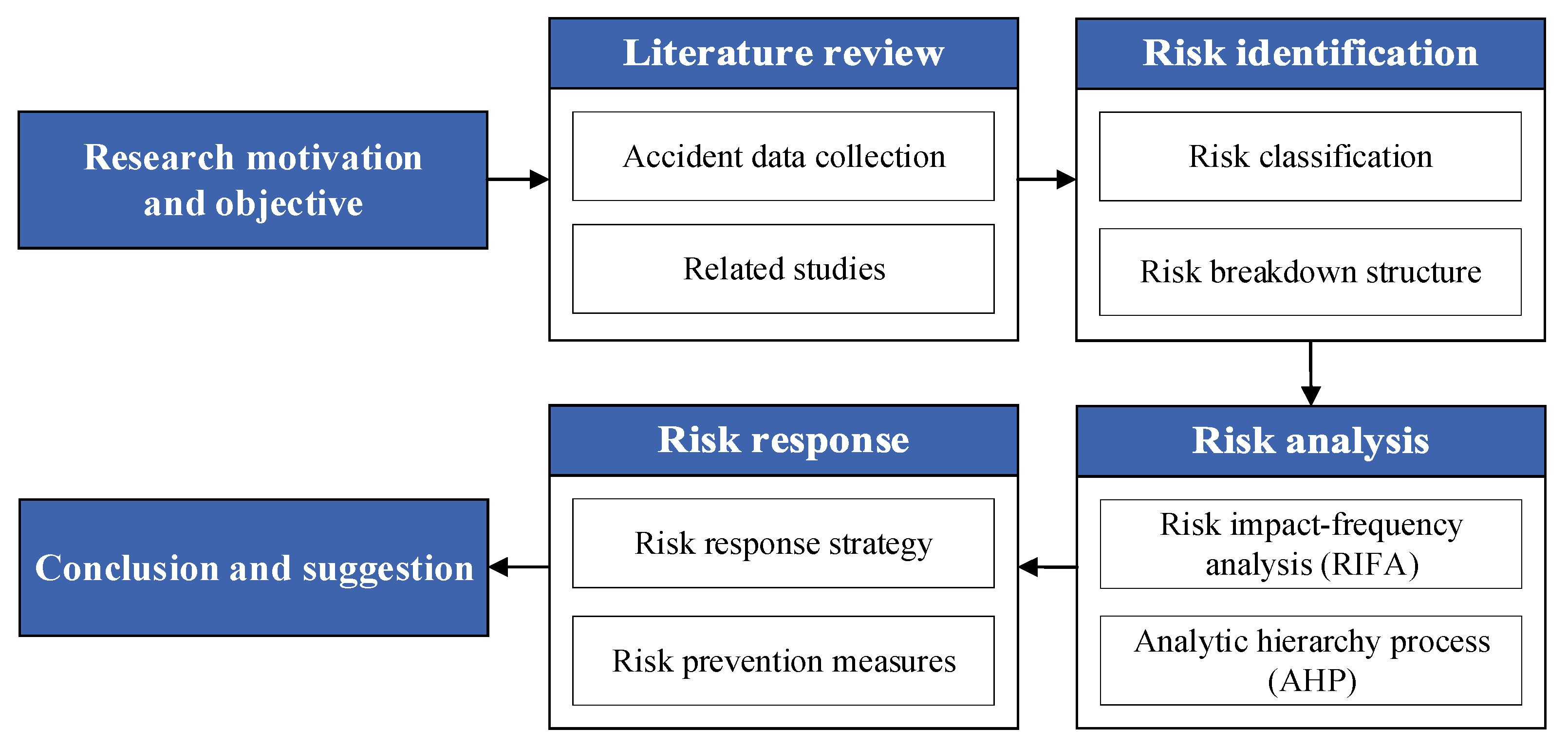

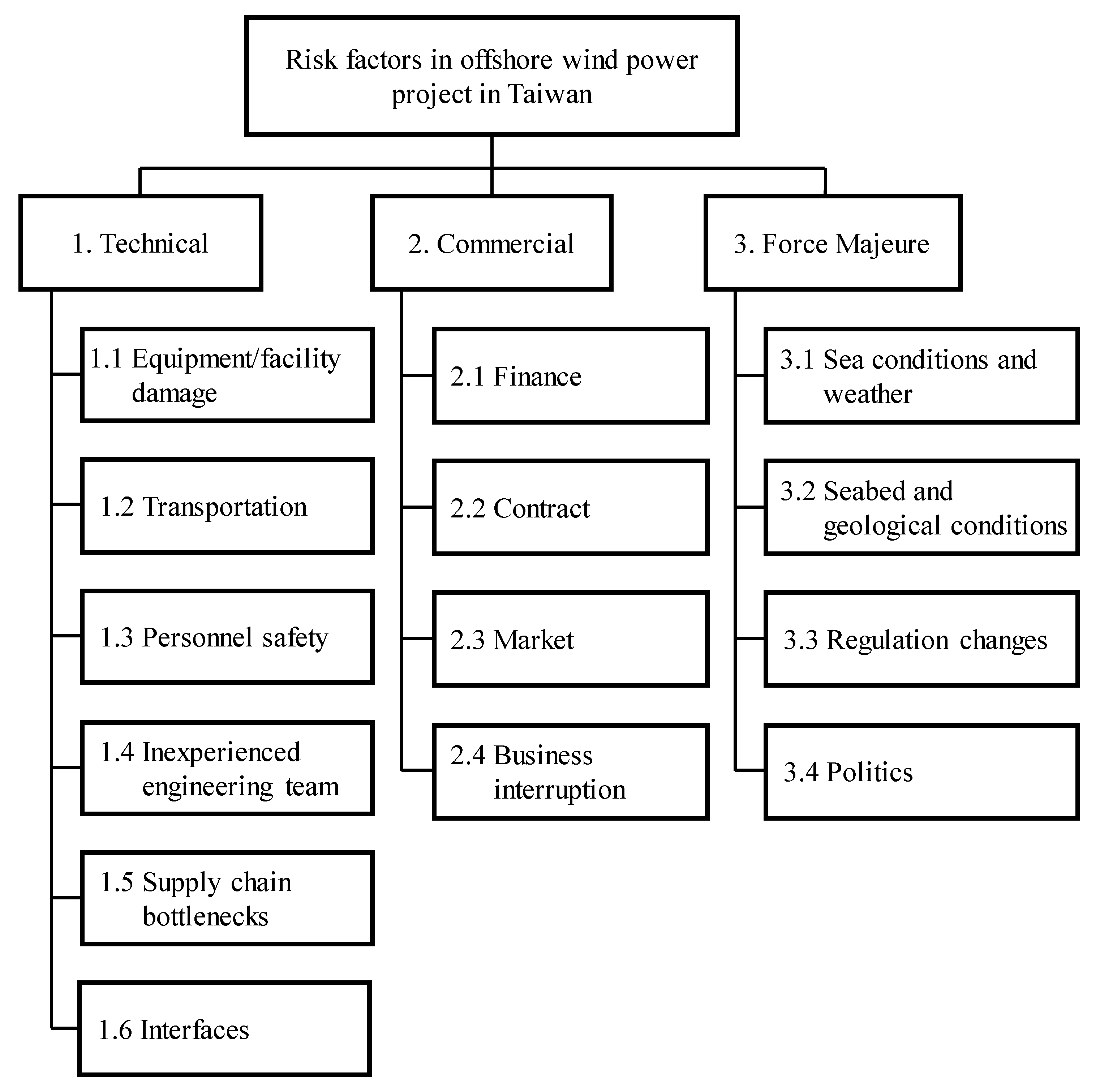
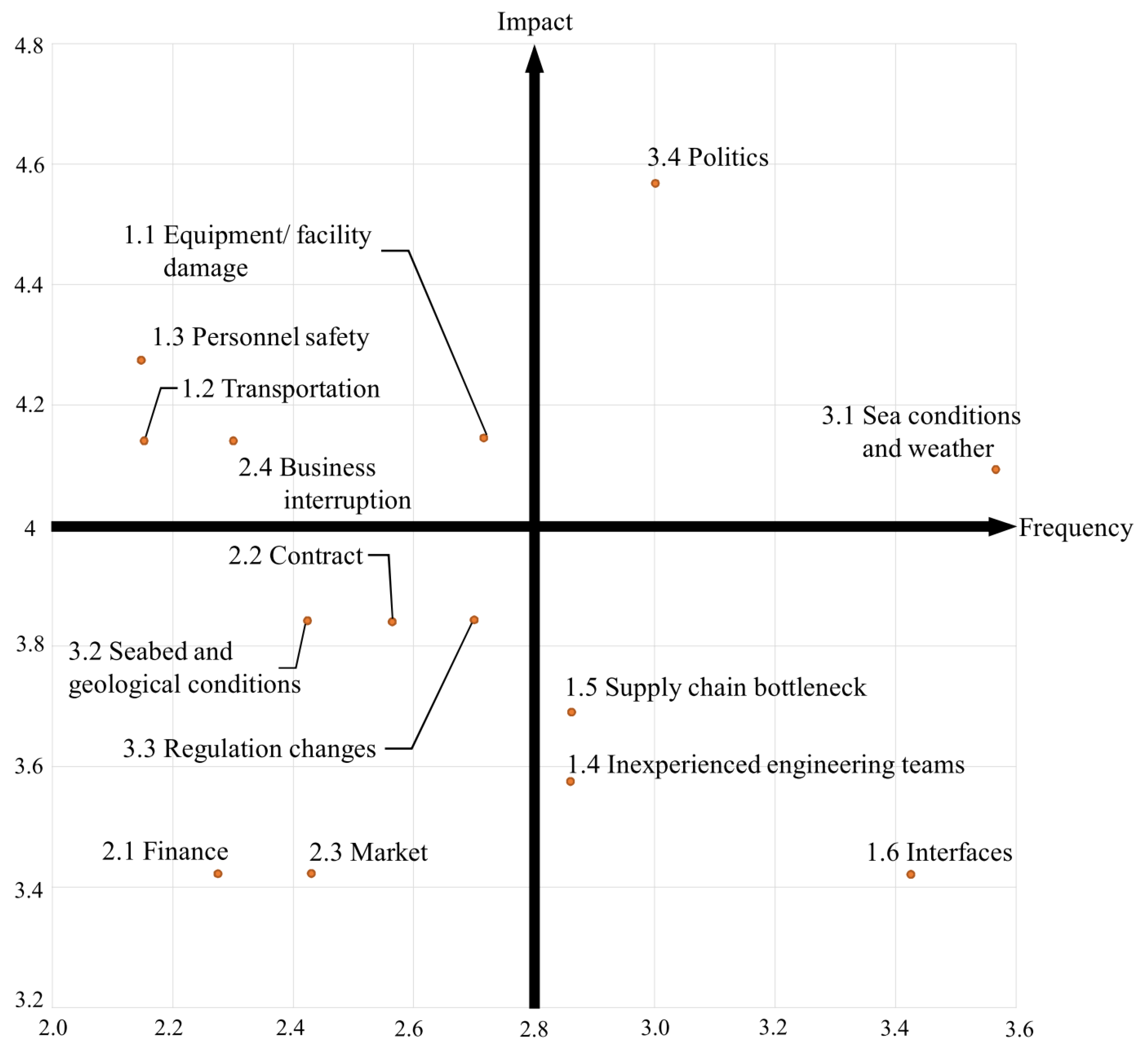
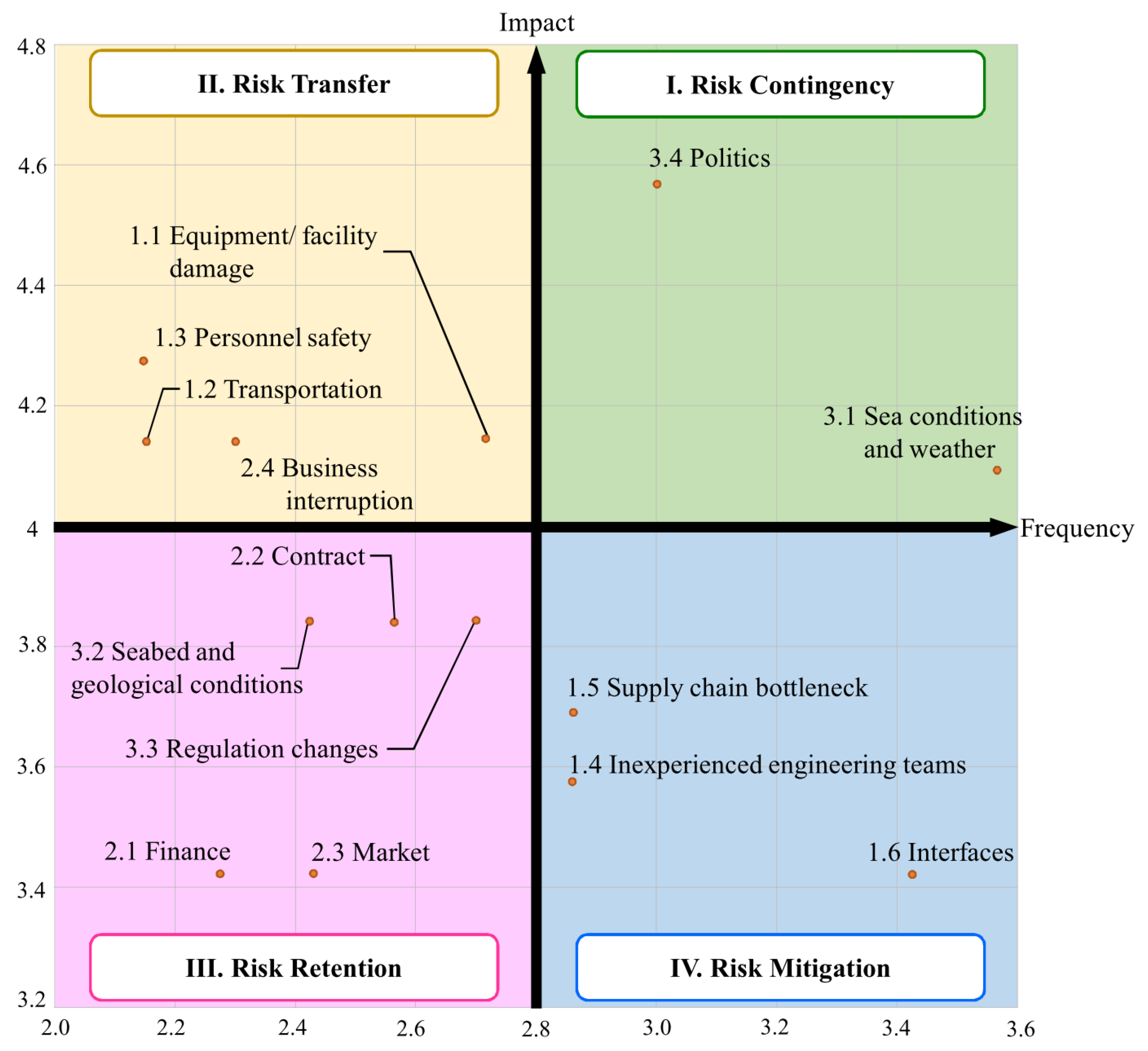
| Importance | Definition | Explanation |
|---|---|---|
| 1 | Equal importance | Two activities contribute equally to the objective |
| 3 | Moderate importance | Experience and judgement slightly favor one activity over another |
| 5 | Essential | Experience and judgement strongly favor one activity over another |
| 7 | Very important | One activity is favored very strongly over another; its dominance is demonstrated in practice |
| 9 | Extremely important | The evidence favoring one activity over another is as strong as possible |
| 2, 4, 6, 8 | Intermediate values | Compromise between two importance score is required |
| Risk Category | Description | Major Stakeholders |
|---|---|---|
| Technical | Technology-related risks, such as related to equipment, machinery, design, transportation, construction, installation, commissioning, operation, and maintenance | Government, banks, developers, suppliers, contractors, and insurance firms |
| Commercial | Commercial risks such as related to finance, contracts, markets, and operations | |
| Force majeure | Unforeseeable risks such as natural disasters, political events, and regulations |
| Industry | Agency | Title | Notes |
|---|---|---|---|
| Developers | TPC | Project Manager | Windfarm under construction |
| wpd | Director | Windfarm under construction | |
| EnBW | Project Development Director | Windfarm development awaiting approval | |
| Maritime contractors | Jan de Nul | Business Development Manager | Currently working at two windfarms |
| Boskalis | Regional Manager | Currently working at a windfarm | |
| Consulting | NIRAS | Project Manager | Consulting for a developer, CIP |
| Insurance | AON | Associate Director | Risk management consulting for two developers, Swancor and TPC |
| Risk Category | Risk Factors | Impact | Frequency | ||
|---|---|---|---|---|---|
| Ave. | Rank | Ave. | Rank | ||
| 1. Technical | 1.1 Equipment/facility damage | 4.143 | 3 | 2.714 | 6 |
| 1.2 Transportation | 4.143 | 3 | 2.143 | 13 | |
| 1.3 Personnel safety | 4.286 | 2 | 2.143 | 13 | |
| 1.4 Inexperienced engineering teams | 3.571 | 11 | 2.857 | 4 | |
| 1.5 Supply chain bottlenecks | 3.714 | 10 | 2.857 | 4 | |
| 1.6 Interfaces | 3.429 | 12 | 3.429 | 2 | |
| 2. Commercial | 2.1 Finance | 3.429 | 12 | 2.286 | 11 |
| 2.2 Contract | 3.857 | 7 | 2.571 | 8 | |
| 2.3 Market | 3.429 | 12 | 2.429 | 9 | |
| 2.4 Business interruption | 4.143 | 3 | 2.286 | 11 | |
| 3. Force Majeure | 3.1 Sea conditions and weather | 4.143 | 3 | 3.571 | 1 |
| 3.2 Seabed and geological conditions | 3.857 | 7 | 2.429 | 9 | |
| 3.3 Regulatory changes | 3.857 | 7 | 2.714 | 6 | |
| 3.4 Politics | 4.571 | 1 | 3.000 | 3 | |
| Risk Category | Weight | Category Rank | Risk Factor | Weight | Factor Rank |
|---|---|---|---|---|---|
| 1. Technical | 0.231 | 3 | 1.1 Equipment/facility damage | 0.024 | 13 |
| 1.2 Transportation | 0.015 | 14 | |||
| 1.3 Personnel safety | 0.085 | 7 | |||
| 1.4 Inexperienced engineering teams | 0.038 | 11 | |||
| 1.5 Supply chain bottlenecks | 0.039 | 10 | |||
| 1.6 Interfaces | 0.029 | 12 | |||
| 2. Commercial | 0.349 | 2 | 2.1 Finance | 0.115 | 3 |
| 2.2 Contract | 0.093 | 6 | |||
| 2.3 Market | 0.041 | 9 | |||
| 2.4 Business interruption | 0.100 | 4 | |||
| 3. Force majeure | 0.421 | 1 | 3.1 Sea conditions and weather | 0.116 | 2 |
| 3.2 Seabed and geological conditions | 0.096 | 5 | |||
| 3.3 Regulation changes | 0.084 | 8 | |||
| 3.4 Politics | 0.125 | 1 |
| Quadrant | Risk Factor | Weight | Quadrant Rank |
|---|---|---|---|
| I. High impact-high frequency | 3.4 Politics | 0.125 | 1 |
| 3.1 Sea conditions and weather | 0.116 | 2 | |
| II. High impact-low frequency | 2.4 Business interruption | 0.100 | 1 |
| 1.3 Personnel safety | 0.085 | 2 | |
| 1.1 Equipment/facility damage | 0.024 | 3 | |
| 1.2 Transportation | 0.015 | 4 | |
| III. Low impact-low frequency | 2.1 Finance | 0.115 | 1 |
| 3.2 Seabed and geological conditions | 0.096 | 2 | |
| 2.2 Contract | 0.093 | 3 | |
| 3.3 Regulation changes | 0.084 | 4 | |
| 2.3 Market | 0.041 | 5 | |
| IV. Low impact-high frequency | 1.5 Supply chain bottlenecks | 0.039 | 1 |
| 1.4 Inexperienced engineering teams | 0.038 | 2 | |
| 1.6 Interfaces | 0.029 | 3 |
| Rank | Risk Factor | Preventive Measure |
|---|---|---|
| 1 | Politics | Most likely political situations can be addressed in exclusion clauses in contracts, allowing contracting parties for discussion. Close attention should be paid to current events to provide early warnings and various relevant situations should be simulated; negotiations with government officials can be attempted when such situations arise. |
| 2 | Personnel safety | Receive professional safety training; enhance HSE management, and avoid working in unfavorable weather. |
| 3 | Equipment/facility damage | Damage caused by weather and sea conditions should be considered in the design of windfarm. Damage caused by human error can be mitigated by improving quality control during manufacturing, transportation, and construction; contracts can include longer warranty periods for equipment and facilities. |
| Transportation | Have professional firms perform fastening, loading and unloading, and transporting; purchase relevant insurance to protect against economic losses; and execute MWS as required by regulations to ensure the safety of offshore personnel, machinery, and ships. | |
| Business interruption | Improve windfarm management to avoid casualties, and use joint ventures to apportion risk among partners. | |
| Sea conditions and weather | Consider Taiwan’s unique climatic conditions in design and avoid offshore operations in unfavorable weather. |
| Rank | Risk Factor | Preventive Measure |
|---|---|---|
| 1 | Sea conditions and weather | Consider Taiwan’s unique climatic conditions in design and avoid offshore operations in unfavorable weather. |
| 2 | Interfaces | Cooperation between domestic and foreign firms enables mutual technological support, and can help communication and integration for vertical interface and horizontal interface. |
| 3 | Politics | Most likely political situations can be addressed in exclusion clauses in contracts, allowing contracting parties for discussion. Close attention should be paid to current events to provide early warnings and various relevant situations should be simulated; negotiations with government officials can be attempted when such situations arise. |
| Rank | Risk Factor | Preventive Measure |
|---|---|---|
| 1 | Politics | Most likely political situations can be addressed in exclusion clauses in contracts, allowing contracting parties for discussion. Close attention should be paid to current events to provide early warnings and various relevant situations should be simulated; negotiations with government officials can be attempted when such situations arise. |
| 2 | Sea conditions and weather | Consider Taiwan’s unique climatic conditions in design and avoid offshore operations in unfavorable weather. |
| 3 | Finance | Stakeholders must perform financial planning and take hedging measures before making investments, increasing capital, and executing projects. |
| Quadrant | Rank | Risk Factor | Preventive Measure |
|---|---|---|---|
| I | 1 | Politics | Most likely political situations can be addressed in exclusion clauses in contracts, allowing contracting parties for discussion. Close attention should be paid to current events to provide early warnings and various relevant situations should be simulated; negotiations with government officials can be attempted when such situations arise. |
| 2 | Sea conditions and weather | Consider Taiwan’s unique climatic conditions in design and avoid offshore operations in unfavorable weather. | |
| II | 1 | Business interruption | Improve windfarm management to avoid casualties, and use joint ventures to apportion risk among partners. |
| 2 | Personnel safety | Receive professional safety training, enhance HSE management, and avoid working in unfavorable weather. | |
| 3 | Equipment/facility damage | Damage caused by weather and sea conditions should be considered in the design of windfarm. Damage caused by human error can be mitigated by improving quality control during manufacturing, transportation, and construction; contracts can include longer warranty periods for equipment and facilities. | |
| III | 1 | Finance | Stakeholders must perform financial planning and take hedging measures before making investments, increasing capital, and executing projects. |
| 2 | Seabed and geological conditions | Conduct geological drilling at the location of each wind turbine foundation, and carry out corresponding analysis and simulation should be carried out, so that the design parameters can be adjusted to ensure effective design. Perform seabed investigations before construction to ensure construction safety. | |
| 3 | Contract | Contracting parties must carefully study and fully understand the contents of contracts, and determine whether they can accept its terms. If necessary, they should seek legal advice. | |
| IV | 1 | Supply chain bottlenecks | Stakeholders must closely monitor suppliers and assist in solving bottleneck problems in a timely manner. |
| 2 | Inexperienced engineering teams | Domestic firms should cooperate with foreign firms, such as by joint contracting; domestic firms may commission professional international firms to provide guidance and review document. Developers can find domestic and foreign consulting firms to provide as general counsel on windfarms to ensure construction quality. | |
| 3 | Interfaces | Cooperation between domestic and foreign firms enables mutual technological support, and can help communication and integration for vertical interface and horizontal interface. |
Publisher’s Note: MDPI stays neutral with regard to jurisdictional claims in published maps and institutional affiliations. |
© 2021 by the authors. Licensee MDPI, Basel, Switzerland. This article is an open access article distributed under the terms and conditions of the Creative Commons Attribution (CC BY) license (https://creativecommons.org/licenses/by/4.0/).
Share and Cite
Chou, J.-S.; Liao, P.-C.; Yeh, C.-D. Risk Analysis and Management of Construction and Operations in Offshore Wind Power Project. Sustainability 2021, 13, 7473. https://doi.org/10.3390/su13137473
Chou J-S, Liao P-C, Yeh C-D. Risk Analysis and Management of Construction and Operations in Offshore Wind Power Project. Sustainability. 2021; 13(13):7473. https://doi.org/10.3390/su13137473
Chicago/Turabian StyleChou, Jui-Sheng, Pin-Chao Liao, and Chung-Da Yeh. 2021. "Risk Analysis and Management of Construction and Operations in Offshore Wind Power Project" Sustainability 13, no. 13: 7473. https://doi.org/10.3390/su13137473
APA StyleChou, J.-S., Liao, P.-C., & Yeh, C.-D. (2021). Risk Analysis and Management of Construction and Operations in Offshore Wind Power Project. Sustainability, 13(13), 7473. https://doi.org/10.3390/su13137473








